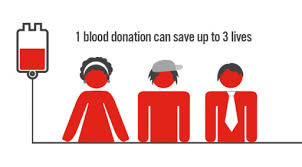Once blood transfusion has taken place, the nurses and doctors check for symptoms of an adverse reaction after a few hours.
Blood transfusion means infusing blood to a needy patient. Blood has components like red blood cells, white blood cells, platelets or clotting factors, and plasma or whole blood which can be transfused to the patient as whole or according to the need. There are five types of white blood cells which play different protective roles during infection control. Platelets helps in clotting blood during wounds and injuries, while plasma helps in controlling the electrolyte balance in body.
When a person comes with prescription for blood transfusion, first a tiny sample of blood is taken from him/her to confirm the prescription and test for other matching components. Once the findings have been obtained, the matching blood from storage is taken and infused into the patient depending on need.
Blood is donated by non-paid volunteers who have undergone level of checks before donation. The eligibility criteria are fixed, and only blood that is determined to be safe is used, says Dr Sangeeta Agarwal, Senior Consultant, Department of Transfusion Medicine, Fortis Memorial Research Institute, Gurugram who shares some important points to ensure a smooth blood transfusion process.
Recipients must be:
Age: 18 to 65
Weight: Above 45 (350 ml donation); above 55 (450 ml donation)
Hemoglobin: 12.5g/dl
Donation Interval: 3 months for males; 4 months for females
BP: 140/90
Pulse: 60 to 100 beats in a minute
Temperature: 37.5 C/ 98.4 F
There are many reasons you might need to receive a blood transfusion like:
*You’ve had major surgery, or a serious injury and you need to replace lost blood.
*You’ve experienced bleeding in your digestive tract from an ulcer or other condition.
*You have an illness like leukemia or kidney disease that causes anemia.
*You’ve received cancer treatments like radiation or chemotherapy.
*You have a blood disorder or severe liver problems.
How to prevent human error when receiving blood
*Double check the blood details before every transfusion by retesting.
*Make sure the recipient and donor details are actualities – they are proved with evidence.
*Correctly labeling items in storage.
Understanding blood donation from a recipient’s point of view:
*There are four types of blood components A, B, AB and O
*Once blood transfusion has taken place, the nurses and doctors check for symptoms of an adverse reaction after a few houurs.
*An ABO incompatibility reaction can occur if you receive the wrong type of blood during a blood transfusion. It’s a rare but serious and potentially fatal response to incompatible blood by your immune system These reactions are extremely rare because doctors are aware of the dangers of using the wrong blood during a transfusion. To prevent this a test is done mixing the donor’s blood with the recipient’s. If a reaction occurs then the match is incompatible.
Blood type A has A antigens, B has B antigens, AB has both A and B antigens and O has no antigens.
If type B is introduced into a blood type A body then antigens will be produced by blood type A which will attack the antibodies of blood type B.
Since AB contains antigens of both A and B, AB blood type are universal recipients. However they can only donate to AB blood type. O blood type is a universal donor.
If the wrong blood is transfused, you will have the following systems:
Initially:
*Fever and chills
*Breathing difficulties
*Muscle aches
*Nausea
*Chest, abdominal, or back pain
*Blood in your urine
*Jaundice
Severe reaction:
*Kidney failure
*Blood Clotting
*Extremely low blood pressure
To rectify the situation:
A saline drip is administered and re transfusion will take place – intravenous fluids will be given.
Source: https://indianexpress.com/article/lifestyle/health/world-blood-donor-day-2019-things-to-consider-to-ensure-safe-blood-transfusion-5781033/lite/
Disclaimer: All information, data and material has been sourced from multiple authors and is for general information and educational purposes only and are not intended to replace the advice of your treating doctor.
The views and nutritional advice expressed are not intended to be a substitute for conventional medical service. If you have a severe medical condition or health concern, see your physician.





